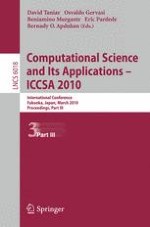2010 | Buch
Computational Science and Its Applications – ICCSA 2010
International Conference, Fukuoka, Japan, March 23-26, 2010, Proceedings, Part III
herausgegeben von: David Taniar, Osvaldo Gervasi, Beniamino Murgante, Eric Pardede, Bernady O. Apduhan
Verlag: Springer Berlin Heidelberg
Buchreihe : Lecture Notes in Computer Science
